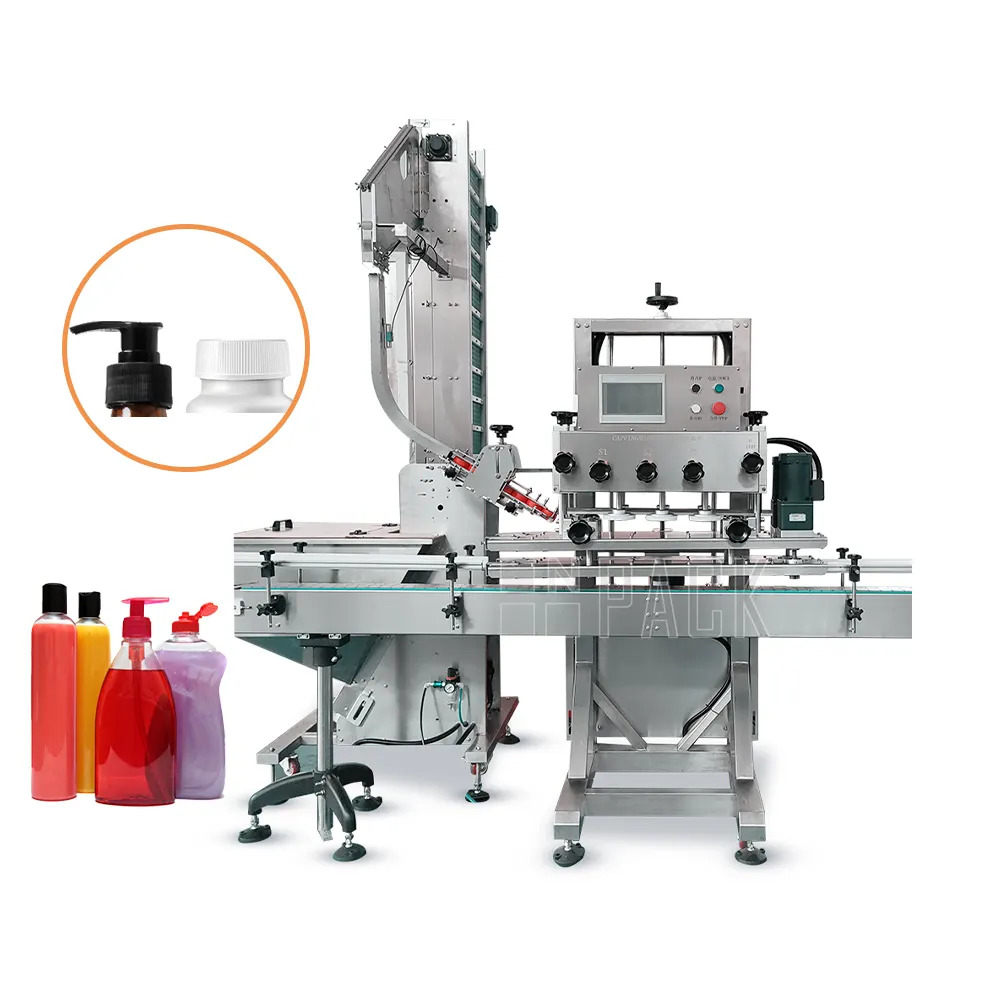Spindle Capping Machine
VKPAK Spindle cappers provide a highly versatile solution for applying and tightening threaded caps. The VKPAK Spindle Capper is the core of an automated system when integrated with our Vibratory or Centrifugal Sorting Bowl, or with the Elevator-style Cap Orientor. Many of our customers use them as a tightener for hand-placed caps and trigger-style caps; and then upgrade them to fully automatic systems by adding components later. Our modular design allows you to add automation components as your production needs change and your budget allows.
Like any person or machine that is good at a job, spindle capping machines, once correctly set up, make the sealing or closing process look easy. The concept seems simple enough, bottles and caps pass through several sets of matched disks, each set of disks adding torque to tighten the cap. Automatic spindle cappers can continuously, and reliably, tighten caps throughout an entire production period. There are, however, more than a couple of tricks to the set up process that ensure the effectiveness of the capping machine.
Continuous capping would not be possible without a continuous supply of caps. Popular delivery systems for automatic spindle cappers include cap elevators and vibratory bowls. Generally, the operator of a packaging line can dump a bulk supply of caps into a hopper to keep the machine running continuously. But even with the cap supply, the delivery machines must be fine tuned to properly function. The first step in pulling maximum performance from the capping equipment will be properly setting up the cap delivery system. Cap elevators will need to be at the right tilt or slant to properly carry closures to the chute and deliver them to the capping machine. Upside down, twisted or turned caps will create jams or will simply not create the desired seal. Improperly oriented caps will fall back to the hopper to start the elevator climb once again. Air jets may also be employed in the delivery or rejection process. Sorting bowls like the vibratory bowl will usually include vibration controls and air jets to move caps up the bowl and also reject those that are improperly aligned.
Once the correctly oriented caps reach the top of the elevator or bowl, they are sent down a chute for presentation to the incoming bottles. Obviously, the chute must be fitted to stabilize the cap as it travels to the capping machine, allowing the lid to slide freely but restricting the lid from tipping, twisting or otherwise changing orientation. At the bottom of the chute, two metal fingers will grasp the cap on each side and a metal tongue will lie across the top of the cap to hold it stable and keep it in the chute until the next bottle arrives. The bottle will then strip the next cap from the chute and proceed into the capping area of the packaging machine.
So now that all the set up has been completed to ensure the cap is properly delivered, the manufacturer of the capping machine must also ensure that the bottle stays stabile during its journey through the machine. While the cap may continue to be stabilized through the entire machine with a bar running between the sets of spindles, the bottle is stabilized using a set of gripper belts. These belts must be adjusted to provide support at the correct spot to avoid tipping the bottle, slowing the bottle or otherwise interfering with the containers progress through the bottle capper. The belts can be raised, lowered and moved in or out to accommodate the bottle being run. In some cases, two sets of gripper belts may be used to provide additional support. For example, a top heavy bottle, an oddly shaped bottle or simply an extremely tall bottle may require two sets of belts to avoid disrupting the bottles progress.
Once the bottle and cap are joined and both are moving slowly into the capping zone, a few more adjustments will be necessary to ensure the consistency and reliability of the bottle capper. The spindle disks will obviously need to contact the bottles at the correct point and with the correct pressure to tighten as desired. Spindle disks can easily be adjusted up, down, in and out. Some applications will use a clutch on the last set of disks to add greater control of the torque being used to tighten the seal. If each of these adjustments are made correctly, then the automatic spindle capping machine will, at last, cap bottles at a continuous pace during the production run.
